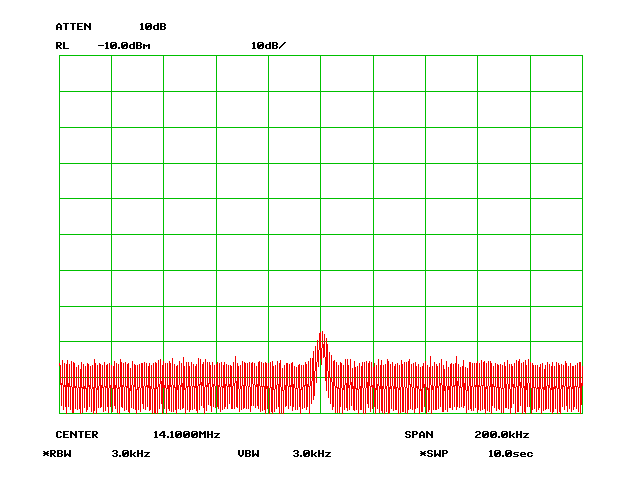 |
Q: Does the level of the grass indicate a quieter receiver or a less sensitive receiver?
A: Actually, there is also a bandwidth issue at play here. We are, in fact, seeing typical spectrum-analyser behaviour.
The IC-7700 Spectrum Scope is a simplified spectrum analyser which samples a 1 MHz "slice" of the 64.455 MHz 1st IF at the output of the first mixer, prior to the roofing filters. It is, in effect, a specialised superhet receiver with a swept 1st LO covering a 1 MHz range. The output of the scope 1st mixer is down-converted to a 200 kHz final IF, which is applied to the scope ADC. The algorithm running in the scope DSP determines the scope's resolution bandwidth (RBW). This is the final IF filter's 3 dB bandwidth, and is also the minimum spacing at which two signals can still be clearly distinguished from one another.
In general, a wide resolution bandwidth is required for wide sweeps whilst a narrow filter is used for narrow sweeps. By using narrower resolution bandwidths, the instrument can reveal sidebands and IMD products. The penalty for using higher resolution is a slower sweep speed.
Wide filters are used when the display needs to be updated rapidly or when wide modulation bandwidths are to be displayed. The minimum resolution bandwidth of a spectrum analyser is a key measure of its ability to measure low level signals adjacent to high level signals - and to provide the lowest displayed noise floor.
Resolution bandwidth (RBW) determines the sensitivity and resolution of the spectrum analyser. Each decade of reduction in resolution bandwidth lowers the spectrum analyser noise floor by approximately 10 dB, allowing lower signals to be measured. Additionally a narrow resolution bandwidth enables closely-spaced signals to be resolved.
It should be noted that a slow sweep speed must be selected for a narrow RBW setting, or the amplitude display will be inaccurate. This is addressed in the scope section of the radio's user manual.
For a ±2.5 kHz span, the measured RBW is 100 Hz; hence the very low grass level at these settings. For a ±100 kHz span, the measured RBW is 2.5 kHz; this manifests itself as a higher grass level. (RBW was measured at the slow sweep speed setting in all cases.)
The relationship between RBW and noise floor (grass level) can be clearly seen from the following IC-7700 screenshots, illustrating a -107 dBm (1 µV) signal at 14.100 MHz with Preamp 2 selected.
The scope sensitivity (minimum visible spike) is -133 dBm with Preamp 2 on. The baseline is at approx. -140 dBm. As noise power is proportional to bandwidth (N = kTB), one can predict a 25X (14 dB) increase in grass level for 2.5 kHz vs. 100 Hz RBW. The increase seen here is in the range 10 to 13 dB, which is close (allowing for inaccuracies in the initial determination of scope RBW).
 |
 |
The following plots, taken with a 14.100 MHz signal at -90 dBm (7µV) on an HP 8563E spectrum analyser, demonstrate that when a wide RBW is selected, the grass level will be significantly higher as the absolute noise power in the IF channel is greater.
As noise power is proportional to bandwidth (N = kTB), one can predict a 10X (10 dB) increase in grass level for 3 kHz vs. 300 Hz RBW. The increase seen here is 10 dB, as expected.
 |
 |
A laboratory spectrum analyser allows independent selection of RBW, span and sweep speed. The IC-7700 permits independent selection of span and sweep speed. Resolution bandwidth has been optimised for each span (sweep width) and sweep speed setting, and is not independently selectable.
The provision of an independent RBW selection menu (with optimum values as defaults) on the IC-7700 would be a very nice refinement. It could be easily implemented in firmware; it would allow the user to select an RBW which would yield a much lower grass level at wide span settings, at the cost of a slower sweep rate. The IC-R9500 has an RBW menu.
Assuming that the receiver's first mixer has some conversion gain, the noise figure of the first active element in the receiver's RF chain (1st mixer or preamp) is dominant, so the question of whether the scope is "noisier" than the main receiver does not arise.
The above remarks are applicable also to the IC-7850/51, IC-7600 and IC-7800. On the IC-7850/51, VBW = Narrow and Averaging = 2, 3 or 4 can be selected to smooth out the grass.
Adam, VA7OJ/AB4OJ's IC-7700 User Review
IC-7700 Instruction Manual, pp. 5-2 to 5-8
IC-7700 Service Manual, p. 9-4
IC-7850 Instruction Manual, p. 6-10
Copyright © 2009, A. Farson VA7OJ/AB4OJ.
Last updated: 09/25/2019